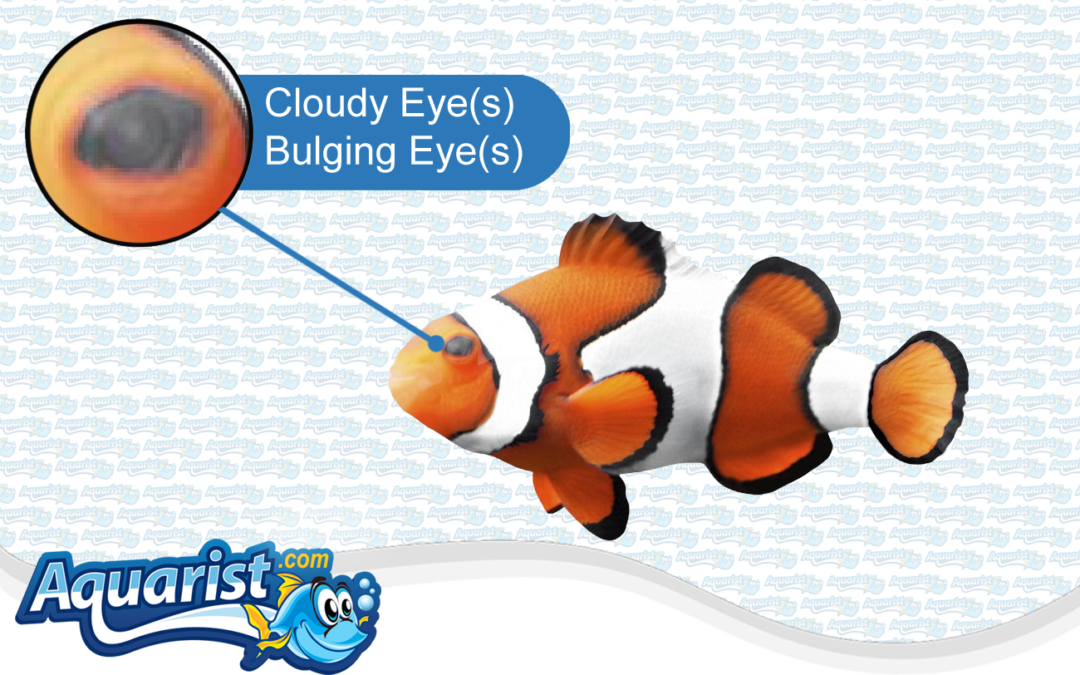Comprehensive Guide to Saltwater Fish Diseases: Cloudy Eyes
Cloudy eyes in saltwater fish is a common condition characterized by a milky or opaque appearance of the eye lens. This condition is often a symptom of an underlying health issue rather than a disease itself. It can be caused by various factors, including poor water quality, bacterial infections, parasitic infestations, or physical injuries. If left untreated, cloudy eyes can lead to impaired vision or even blindness. This guide provides a detailed overview of cloudy eyes, covering its causes, symptoms, treatment options, and preventive measures to help manage and prevent this condition in your saltwater aquarium.
What is Cloudy Eyes?
Cloudy eyes refer to a condition where the eyes of a fish appear cloudy, milky, or hazy. It can affect one or both eyes and may vary in severity, from a slight haze to complete opacity. The condition usually indicates an underlying issue, such as an infection, injury, or environmental stressor, that needs to be addressed promptly to prevent further complications.
Causes of Cloudy Eyes
Several factors can contribute to the development of cloudy eyes in saltwater fish. The most common causes include:
- Poor water quality: High levels of ammonia, nitrite, or nitrate can irritate fish eyes and lead to cloudiness. Improper pH or salinity levels may also contribute to the condition.
- Bacterial infections: Bacteria such as Mycobacterium or Streptococcus can infect the eyes, causing inflammation and cloudiness.
- Parasitic infestations: Parasites such as flukes or protozoans can attach to the eyes, leading to irritation and cloudiness.
- Physical injury: Trauma to the eye from aggressive tank mates, rough handling, or sharp objects in the aquarium can result in cloudy eyes.
- Poor nutrition: A diet lacking in essential vitamins, especially vitamin A, can lead to weakened immune function and eye problems.
- Stress: Factors such as overcrowding, temperature fluctuations, and sudden environmental changes can weaken the fish's immune system, increasing the risk of eye problems.
Symptoms of Cloudy Eyes
Recognizing the symptoms of cloudy eyes early is essential for effective treatment. Common signs include:
- Milky or hazy appearance of the eyes: The eyes may look cloudy, as if covered by a thin film or mist.
- Swollen or bulging eyes: In some cases, the eyes may appear swollen or protrude abnormally, indicating inflammation or infection.
- Behavioral changes: Fish with cloudy eyes may become less active, have difficulty finding food, or hide more often due to impaired vision.
- Scratching or flashing: Fish may rub their eyes against rocks, sand, or decorations in an attempt to relieve discomfort.
- Redness or inflammation: The tissue around the eyes may appear red or swollen, suggesting an underlying infection.
Treatment Options for Cloudy Eyes
Treating cloudy eyes involves addressing the underlying cause, improving water quality, and providing supportive care. The following steps can help manage and treat cloudy eyes effectively:
- Improve water quality: Regularly perform water changes and monitor water parameters to ensure that ammonia, nitrite, and nitrate levels are within safe ranges. Stable pH and salinity levels should also be maintained.
- Use antibacterial or antiparasitic medications: If a bacterial infection or parasite is suspected, treat the affected fish with suitable medications. Common options include antibiotics like erythromycin for bacterial infections or praziquantel for parasites.
- Quarantine affected fish: Isolate the fish in a separate quarantine tank for treatment to prevent the spread of any potential infections and allow closer monitoring.
- Provide a nutritious diet: Feed fish a balanced diet that includes vitamin-enriched foods to support the immune system and promote healing. Consider adding vitamin supplements, especially those containing vitamin A.
- Minimize stress: Ensure that the tank environment is stable, avoid overcrowding, and provide hiding places to reduce stress on the fish.
Preventing Cloudy Eyes
Prevention is the best approach to managing cloudy eyes in saltwater fish. The following steps can help reduce the risk of this condition:
- Maintain optimal water quality: Regularly test and monitor water parameters, including pH, ammonia, nitrite, and nitrate levels. Perform routine water changes to keep the tank clean and healthy.
- Quarantine new fish: Quarantine new arrivals for at least 2-4 weeks before introducing them to the main tank. This helps prevent the introduction of diseases and parasites.
- Provide a balanced diet: Offer a varied diet with high-quality foods and vitamin supplements to boost the immune system and promote eye health.
- Avoid overcrowding: Keep the stocking levels appropriate for the size of the aquarium to reduce stress and aggression among tank mates.
- Handle fish with care: Avoid rough handling during tank maintenance, as physical trauma can lead to eye injuries.
Pro Tips for Treating and Preventing Cloudy Eyes
- Act quickly: Early intervention can prevent minor eye cloudiness from developing into more serious infections. Treat symptoms as soon as they appear.
- Monitor water quality closely: Poor water conditions can exacerbate eye problems. Regularly check water parameters and make adjustments as needed.
- Use natural healing aids: Products like Melafix, which is made from tea tree oil, can help reduce inflammation and support healing.
- Disinfect equipment: After treating infected fish, thoroughly clean and disinfect any equipment used, such as nets, buckets, or siphons, to prevent the spread of pathogens.
Common Mistakes to Avoid When Treating Cloudy Eyes
To ensure effective treatment and avoid complications, be mindful of these common mistakes:
- Stopping treatment too early: Even if symptoms appear to improve, continue the full course of treatment to ensure the underlying cause is fully addressed.
- Overusing medications: Avoid using multiple treatments simultaneously without guidance, as this can stress the fish and negatively impact water quality.
- Not addressing underlying causes: Simply treating the symptoms without addressing poor water quality, aggressive tank mates, or other stress factors will likely result in recurrence.
- Skipping quarantine for new fish: Introducing new fish without quarantine can introduce pathogens into the main tank, leading to outbreaks of cloudy eyes and other diseases.
Understanding the Impact of Cloudy Eyes on Fish Health
Cloudy eyes can significantly affect the health and well-being of saltwater fish. If left untreated, it can lead to permanent vision impairment, secondary infections, and overall poor health. Maintaining a clean tank environment, providing a nutritious diet, and addressing underlying stressors are essential for preventing and treating this condition. With proper care and timely intervention, most fish can recover fully from cloudy eyes.
Conclusion
Cloudy eyes in saltwater fish is a common but preventable condition that can be managed effectively with prompt attention and the right care. By recognizing the symptoms, understanding the causes, and taking appropriate treatment and preventive measures, you can help ensure the health and well-being of your fish. Maintaining optimal water quality, providing a safe tank environment, and quarantining new fish are key steps in preventing cloudy eyes. With proper care, you can keep your saltwater aquarium thriving and your fish healthy.

